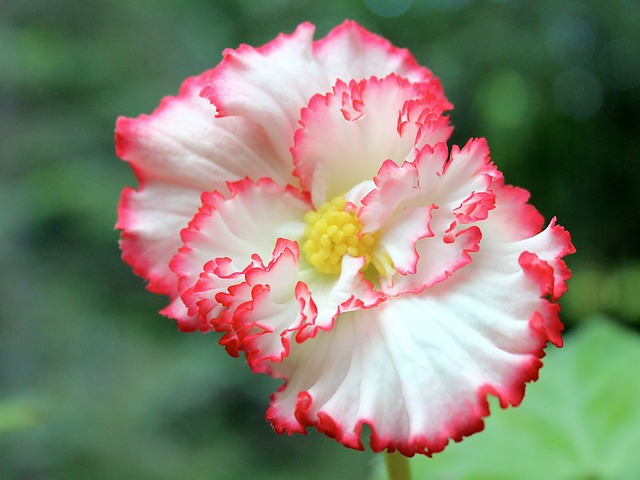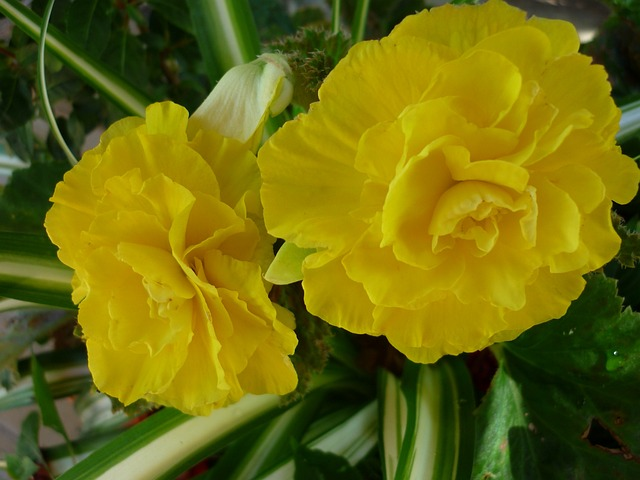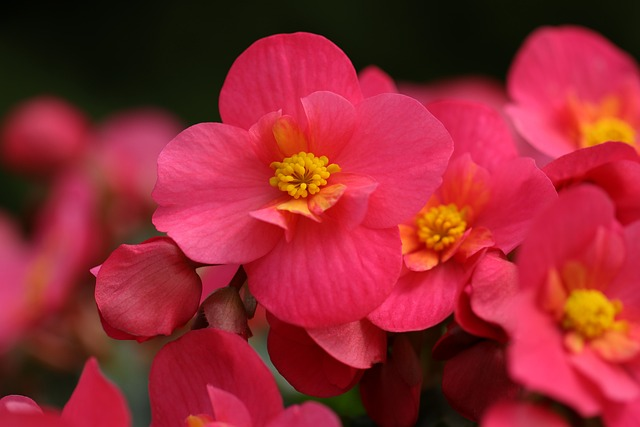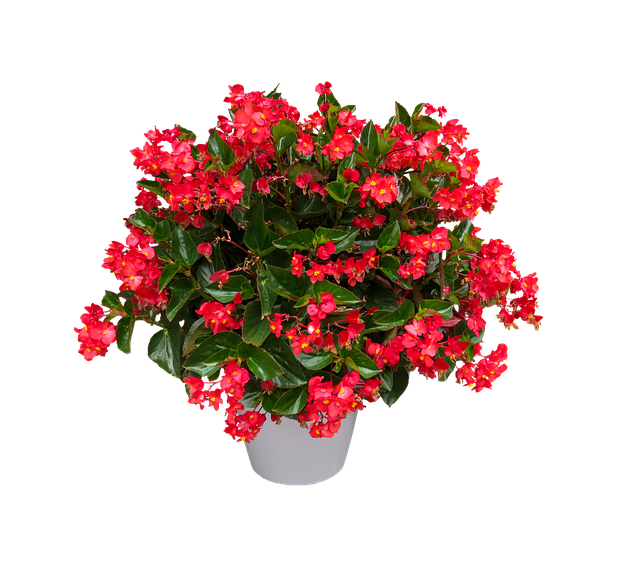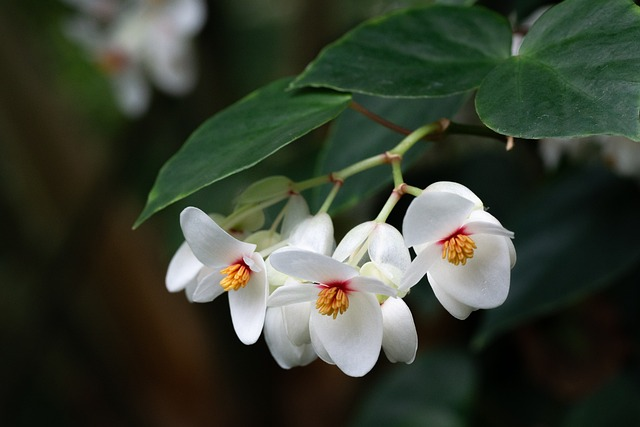HousePlantJoy is supported by our audience. When you purchase through one of our links, we may earn a small affiliate commission. As an Amazon Associate I earn from qualifying purchases. Your cost is not affected.
==================
Types of Begonia Houseplants
In this comprehensive guide, I take you through the wonderful world of houseplant begonia, exploring the different types of begonias indoor, their care, and how to choose the perfect begonia for your space. Whether you’re a seasoned plant lover or just starting your indoor garden, I hope this guide will inspire you to discover the dazzling beauty of begonias and help you find your perfect plant.
Why Choose Begonias for Your Home?
Begonias are a fantastic choice for any home, thanks to their incredible versatility and adaptability. With over 1,800 species and countless hybrids, there is a begonia type to suit every taste and style. From the elegant, cascading leaves of the Rex begonia to the delicate, rose-like blooms of the tuberous begonia, these plants offer a stunning range of colors, shapes, and textures.
Not only are begonias visually impressive, but they are also relatively low-maintenance, making them an ideal choice for busy homeowners or those new to plant care. Many begonia types can thrive in a variety of indoor environments, tolerating low light, humidity fluctuations, and even neglect.
Moreover, begonias can serve as a natural air purifier, helping to improve the air quality in your home by removing harmful toxins such as formaldehyde and benzene. With their beauty, versatility, and health benefits, it’s no wonder that begonias are a popular choice for indoor gardens.
Understanding the Different Types of Begonia Houseplants
When it comes to begonia types, the possibilities are nearly endless. To help you navigate the vast world of begonias, I’ve broken them down into four main categories: fibrous-rooted, rhizomatous, tuberous, and cane. Each of these categories has its unique characteristics, growth habits, and care requirements, so understanding the differences between them is essential when selecting the perfect begonia for your space.
Fibrous-Rooted Begonias
Fibrous-rooted begonias are perhaps the most common and easiest to care for, making them a favorite among novice plant owners. These begonias have shallow, branching root systems that help them absorb moisture and nutrients efficiently. They are typically grown for their striking foliage, which can range from deep green to vibrant shades of red, orange, and yellow.
Some popular fibrous-rooted begonia types include the wax begonia (Begonia semperflorens), which has glossy, rounded leaves and small, colorful flowers, and the angel-wing begonia (Begonia coccinea), known for its unique, wing-shaped leaves and clusters of delicate blooms.
Rhizomatous Begonias
Rhizomatous begonias are characterized by their thick, horizontal stems, or rhizomes, which grow along the soil surface. These begonias are primarily grown for their stunning foliage, which comes in a wide range of colors, patterns, and textures. The most well-known rhizomatous begonia is the Rex begonia, which boasts large, intricately-patterned leaves in shades of green, silver, red, and purple.
Rhizomatous begonias are often considered more challenging to care for than their fibrous-rooted counterparts, as they require a delicate balance of light, humidity, and soil moisture to thrive.
Tuberous Begonias
Tuberous begonias are known for their show-stopping blooms, which can range in size from small, delicate flowers to large, rose-like blossoms. These begonias grow from underground storage organs called tubers, which store energy for the plant during its dormant period. Tuberous begonias are typically grown as annuals, as they require a period of dormancy in the winter months.
Some popular tuberous begonia varieties include the Nonstop begonia, known for its large, double flowers in a rainbow of colors, and the Rieger begonia, which has smaller, star-shaped blooms and glossy, green foliage.
Cane Begonias
Cane begonias, also known as “bamboo begonias,” are characterized by their tall, slender stems and elegant, cascading foliage. These begonias are typically grown for their foliage, which can range from simple green leaves to vibrant, variegated patterns. Some cane begonias also produce small, fragrant flowers in shades of pink, white, or red.
Cane begonias are relatively easy to care for, making them a popular choice for indoor gardens. Popular varieties include the “angel-wing” begonia (Begonia coccinea), which has unique, wing-shaped leaves and delicate blooms, and the “dragon-wing” begonia (Begonia x hybrida), which features large, glossy leaves and clusters of small, bell-shaped flowers.
Popular Indoor Begonia Varieties
Now that we’ve explored the main types of begonia houseplants, let’s dive into some of the most popular indoor begonia varieties. These plants have been carefully selected for their beauty, versatility, and ease of care, making them a perfect addition to any indoor garden.
Rex Begonia (Begonia Rex-Cultorum)
Rex begonias are perhaps the most famous of all indoor begonia varieties, renowned for its stunning foliage and intricate leaf patterns. With its large, velvety leaves in shades of green, silver, red, and purple, the Rex begonia makes a striking statement in any room. This rhizomatous begonia prefers bright, indirect light and high humidity, making it well-suited for terrariums or bathrooms with natural light.
Rex begonia offers some of the showiest foliage, although most begonias offer quite interesting foliage.
Wax Begonia (Begonia Semperflorens)
The wax begonia is a classic choice for indoor gardens, thanks to its compact size and easy-care nature. This fibrous-rooted wax begonia features glossy, rounded leaves and small, colorful flowers that bloom nearly year-round. Wax begonias are adaptable to a variety of light conditions, making them a versatile choice for any space.
They sport a variety of colors including red flowers, white flowers, yellow flowers, or pink blooms. This compact plant might be a favorite as a gift.
Angel-Wing Begonia (Begonia Coccinea)
The angel-wing begonia is a stunning cane begonia known for its distinctive, wing-shaped leaves and delicate, pendulous blooms. With its elegant form and cascading foliage, the angel-wing begonia is perfect for hanging baskets or as a statement piece on a plant stand. This begonia prefers bright, indirect light and consistent moisture, so be sure to keep its soil evenly moist but not waterlogged.
Caring for Your Begonia Houseplant
While different types of begonias have unique care requirements, some general guidelines apply to most begonia varieties. By following these simple tips, you help ensure that your begonia houseplant thrives in its new environment.
Begonias thrive when grown indoors. Just follow our guidelines for these indoor plants. Also, they grow well in standard pots or hanging baskets.
Light
Begonias generally prefer bright, indirect light, as direct sunlight can cause their delicate leaves to scorch. However, some begonia varieties can tolerate lower light levels, making them a suitable choice for rooms with less natural light. To ensure your begonia receives adequate light, try placing it near a north- or east-facing window, or use a grow light to supplement its light intake.
Water
When it comes to watering your begonia, it’s essential to strike the right balance between moisture and drainage. Most begonia types prefer evenly moist soil, but they are sensitive to overwatering, which can lead to root rot. To prevent overwatering, allow the top inch of soil to dry out between waterings, and use a well-draining potting mix.
Humidity
Many begonia varieties thrive in high humidity, so it’s essential to provide the proper humidity levels for your plant. You can increase humidity around your begonia by using a pebble tray, a humidifier, or by misting the plant regularly. However, be sure to avoid misting the leaves of hairy or fuzzy begonias, as this can cause the leaves to rot.
Tips for Choosing the Right Begonia Type for Your Space
With so many begonia types to choose from, selecting the perfect plant for your space can be a daunting task. Here are a few tips to help you find the right begonia for your home:
- Consider your light conditions: Some begonias can tolerate lower light levels, while others require bright, indirect light to thrive. Be sure to choose a begonia type that suits your space’s lighting conditions.
- Think about your desired plant size: Begonias come in a range of sizes, from compact, bushy plants to tall, cascading varieties. Consider how much space you have available. Then choose a begonia type that will fit comfortably in your home.
- Look for easy-care varieties: If you’re new to plant care or have a busy schedule, opt for low-maintenance begonia types such as wax or angel-wing begonias, which are more forgiving and require less attention.
- Choose based on your aesthetic preferences: Each begonia type offers its unique beauty, so it’s essential to select a plant that appeals to your personal style and complements your home decor.
Video Credit: @GreenYardTV
Propagating and Growing Different Types of Begonias
One of the most rewarding aspects of plant care is propagating your begonias and watching new plants grow from cuttings or divisions. Different begonia types require different propagation methods, so it’s essential to understand the specific requirements of your chosen variety.
Propagating Fibrous-Rooted and Cane Begonias
Fibrous-rooted and cane begonias are typically propagated through stem cuttings. To do this, simply take a 3-4 inch cutting from a healthy stem, remove the lower leaves, and dip the cut end in rooting hormone. Then, place the cutting in a small pot filled with moist, well-draining potting mix. Keep the cutting in a warm, humid environment and mist regularly to maintain moisture levels. Within a few weeks, your cutting should begin to develop roots and new growth.
Propagating Rhizomatous Begonias
Rhizomatous begonias can be propagated through leaf cuttings or by dividing the rhizome. To propagate through leaf cuttings, remove a healthy leaf from the plant and cut it into wedges, ensuring each section has a main vein. Then, place the leaf wedges in a tray filled with moist potting mix and cover with a plastic bag to create a humid environment. Within a few weeks, new plants should begin to form at the base of each leaf cutting.
To propagate through rhizome division, carefully remove the plant from its pot and gently separate the rhizome into sections, ensuring each division has at least one growing point. Replant the divisions in fresh, moist potting mix and keep them in a warm, humid environment until new growth emerges.
Propagating Tuberous Begonias
Tuberous begonias are typically propagated by dividing the tubers. To do this, wait until the plant has gone dormant in the winter months, then carefully lift the tubers from the soil and separate them into sections, ensuring each division has at least one “eye” or growing point. Replant the divisions in fresh, well-draining potting mix and keep them in a cool, dry environment until new growth emerges.
Learn to propagate a Boston Fern and expand your indoor plant collection with this comprehensive guide. Master the art of nurturing and multiplying your Boston Ferns by learning proven propagation techniques and caring for the new offspring.
Troubleshooting Common Begonia Problems
Like all plants, begonias can experience a range of issues, from pests and diseases to environmental stress. Here are some common problems you may encounter with your begonia and how to address them:
Yellow or Dropping Leaves
Yellow or dropping leaves can indicate a range of issues, from overwatering to underwatering, nutrient deficiencies, or pest infestations. To address this issue, check your plant’s soil moisture levels, adjust its watering schedule, and ensure it’s receiving adequate light and nutrients. If pest infestations are the cause, treat your plant with an appropriate insecticide or natural remedy.
Powdery Mildew
Powdery mildew appears as a white, powdery substance on the leaves and stems of your begonia, caused by a fungal infection. To treat this issue, remove any infected leaves or stems and treat the plant with a fungicide or natural remedy. Ensure your plant has adequate air circulation and avoid getting its leaves wet, as this can promote fungal growth.
Pest Infestations of All Types of Begonia Houseplants
Common pests that affect begonias include spider mites, mealybugs, and thrips. To address pest infestations, first, isolate your affected plant to prevent the spread of pests to other plants. Then, treat your plant with an appropriate insecticide or natural remedy. Regularly inspect your plants for signs of pest infestations and take action promptly to prevent severe damage.
Unique and Rare Begonia Varieties to Explore
For those looking to expand their indoor garden collection, there are many unique and rare begonia types to explore. Here are a few standout varieties to consider:
Black Begonia (Begonia Rex-Cultorum ‘Black Mamba’)
The black begonia is a rare and striking variety, featuring large, velvety leaves in a deep, dark shade of purple-black. This rhizomatous begonia prefers bright, indirect light and high humidity, making it well-suited for terrariums or bathrooms with natural light.
Iron Cross Begonia (Begonia Masoniana)
The iron cross begonia is a unique and eye-catching plant, featuring large, textured leaves with distinctive markings resembling an iron cross. This rhizomatous begonia prefers medium to bright, indirect light and high humidity, making it an ideal choice for terrariums.
Snake-Skin Begonia (Begonia ‘Rajah’)
The snake-skin begonia is a stunning rhizomatous begonia, featuring large, textured leaves with a unique, snakeskin-like pattern. This begonia prefers bright, indirect light and high humidity, making it well-suited for terrariums or bathrooms with natural light.
Finding Your Perfect Begonia Plant, Explore Types of Begonia Houseplants
With so many types of begonia plants to choose from, finding your perfect plant can be a thrilling and rewarding experience. Whether you’re drawn to the striking foliage of the Rex begonia or the delicate blooms of the tuberous begonia, there is a begonia variety to suit every taste and style.
By following the care tips outlined in this guide and exploring different begonia types, you can create a beautiful and thriving indoor garden that showcases the dazzling beauty of these versatile and captivating plants. So why not start your begonia journey today and discover the endless possibilities of begonia houseplants?
Begonia Plants, Quick Begonia Facts
- Begonias prefer shade or indirect light over direct sun. In fact, this makes them great houseplants for less brightly lit areas of your home.
- Some Begonias have upright and mounding habits making them great for garden beds. Other have a trailing habit perfect for containers or hanging baskets.
- They make great display plants for the attractiveness of the foliage or their flowers or both.
- Begonias come in four main types: wax, tuberous, cane, and rhizomatous.
- If grown outdoors in the summer, Begonias can be overwintered as house plants.
- Begonias make fantastic houseplants for containers or hanging baskets.
FAQs
How do I choose the right type of begonia houseplant for my home?
Picking the perfect begonia houseplant for your home is all about understanding your preferences and the conditions in your living space. Take into account factors like the amount of natural light available, the level of humidity, and the overall temperature. For instance, if you have a sunny spot by a window, you might consider a Begonia rex with its vibrant and patterned foliage. If you prefer low-maintenance plants, the tough and adaptable Begonia maculata could be a great fit. Remember, there’s a begonia out there for every type of home!
I'm a beginner with houseplants. Which begonia variety should I start with?
If you’re new to the world of houseplants, it’s best to begin with a begonia that is forgiving and easy to care for. The Begonia rex, commonly known as the “Painted-Leaf Begonia,” is a great option for beginners. Its beautiful foliage comes in a wide range of colors and patterns, adding a touch of elegance to your home. With proper care, such as providing indirect light and keeping the soil moist but not waterlogged, you’ll find the Begonia rex to be a delightful and manageable companion on your houseplant journey.
Can I grow begonias in areas with limited natural light?
Absolutely! While begonias generally appreciate bright, indirect light, some varieties can tolerate lower light conditions. For areas with limited natural light, consider the Begonia bowerae or the Begonia masoniana, both of which can adapt to lower light levels. Just make sure to keep them away from direct sunlight, as it can scorch their delicate leaves. If you’re unsure about the lighting conditions in your space, observe the light patterns throughout the day and select a begonia variety that matches those conditions.
Are begonias safe for pets? I have a mischievous cat who likes to chew on plants.
While begonias are popular houseplants, some varieties can be toxic to pets, including cats and dogs, if ingested in large quantities. The tuberous begonias and some types of fibrous begonias contain oxalates, which can cause mouth irritation, drooling, and digestive issues. If you have a curious and plant-chewing pet, it’s best to keep begonias out of their reach or opt for pet-friendly houseplants. Consult with your local veterinarian or do some research to find pet-safe alternatives that can add greenery to your home without posing a risk to your furry friends.
You Might Also Like…


